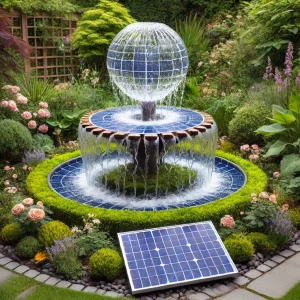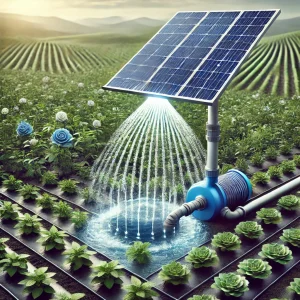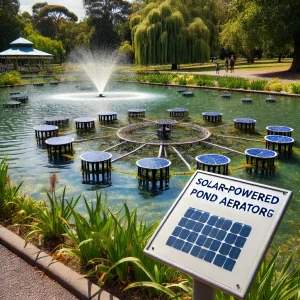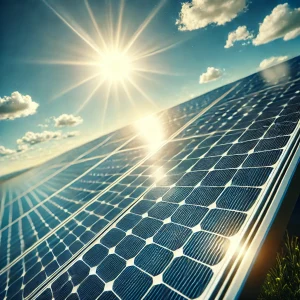Solar-powered landscape features have emerged as a popular and eco-friendly choice as we continue to seek sustainable solutions for our homes and environments. This blog explores the advantages, types, and future trends of solar-powered lighting and water systems, providing homeowners and landscapers in British Columbia with valuable insights into how to enhance their outdoor spaces sustainably.

Introduction to Solar-Powered Landscape Features
Solar-powered landscape features harness the sun’s energy to power various outdoor elements, reducing reliance on non-renewable energy sources. These features include lighting systems illuminating gardens and pathways and water systems maintaining ponds and fountains. By integrating these solar-powered solutions, homeowners can enjoy aesthetically pleasing and functional landscapes while minimizing their environmental footprint.

Benefits of Using Solar-Powered Lighting in Landscapes
Solar-powered lighting offers several benefits that make it an attractive option for any landscape:
- Energy Efficiency: Solar lights convert sunlight into electricity, which means they operate independently of the grid, reducing energy consumption and electricity bills.
- Eco-Friendly: These lights produce no greenhouse gases, making them an environmentally friendly choice.
- Easy Installation: Since solar lights do not require extensive wiring, they can be installed quickly and easily anywhere.
- Low Maintenance: With fewer components and no reliance on electrical wiring, solar lights require minimal maintenance.
- Versatility: Available in various styles and intensities, solar lights can be used for accent lighting, path lighting, or security lighting.

Types of Solar-Powered Water Systems and Their Advantages
Solar-powered water systems are another excellent addition to sustainable landscapes. Here are some common types and their benefits:
- Solar-Powered Fountains: These fountains use solar energy to circulate water, creating a soothing and visually appealing feature. They are perfect for gardens, patios, and balconies.
- Solar-Powered Pond Aerators: Aerators help maintain water quality in ponds by increasing oxygen levels, which is essential for fish and plant health. Solar-powered aerators are cost-effective and eco-friendly.
- Solar-Powered Water Pumps: These pumps can be used for various applications, including irrigation systems, water features, and waterfalls. They are highly efficient and reduce the need for electrical infrastructure.

Real-World Examples of Successful Implementation
Numerous properties in British Columbia have successfully integrated solar-powered landscape features. For instance, a residential garden in Vancouver features solar-powered path lights that guide visitors through a beautifully lit garden, enhancing safety and aesthetics. Similarly, a public park in Victoria uses solar-powered fountains and pond aerators to maintain its water features, showcasing the practical benefits of these sustainable solutions.

Tips for Choosing and Installing Solar-Powered Landscape Features
When selecting and installing solar-powered landscape features, consider the following tips:
- Assess Sunlight Exposure: Ensure the location receives adequate sunlight throughout the day for optimal performance.
- Quality Matters: Invest in high-quality solar products to ensure longevity and efficiency.
- Placement: Position solar panels and features to avoid shading from trees or buildings.
- Maintenance: Regularly clean solar panels to remove dust and debris that can obstruct sunlight.
Future Trends in Solar-Powered Landscape Technology
The future of solar-powered landscape features looks promising, with technological advancements driving innovation. Emerging trends include:
- Improved Efficiency: Newer solar panels are becoming more efficient, improving performance in low-light conditions.
- Smart Integration: Smart solar lights and water systems can be controlled remotely via smartphones, offering greater convenience and customization.
- Hybrid Systems: Combining solar power with other renewable energy sources like wind or geothermal can further enhance sustainability.

Cost-Effectiveness and ROI of Solar-Powered Features
While the initial investment in solar-powered landscape features may be higher than traditional options, the long-term savings and benefits outweigh the costs. Reduced electricity bills, minimal maintenance expenses, and the added value to your property contribute to a favourable return on investment (ROI).

Potential Challenges or Limitations
Despite the numerous benefits, there are some challenges to consider:
- Initial Cost: The upfront cost of high-quality solar-powered features can be significant.
- Weather Dependency: Solar-powered systems rely on sunlight, which can be less predictable in regions with frequent cloud cover or heavy rainfall.
- Performance Variability: The efficiency of solar-powered systems can vary depending on the season and geographical location.
Solar-powered landscape features offer a sustainable and aesthetically pleasing solution for homeowners and landscapers in British Columbia. These features provide numerous benefits by harnessing the sun’s power, from energy savings to reduced environmental impact. As technology advances, the future of solar-powered landscape features looks brighter than ever, promising even greater efficiency and integration. Whether you’re looking to illuminate your garden or maintain a pond, solar-powered options are a smart and eco-friendly for any landscape.